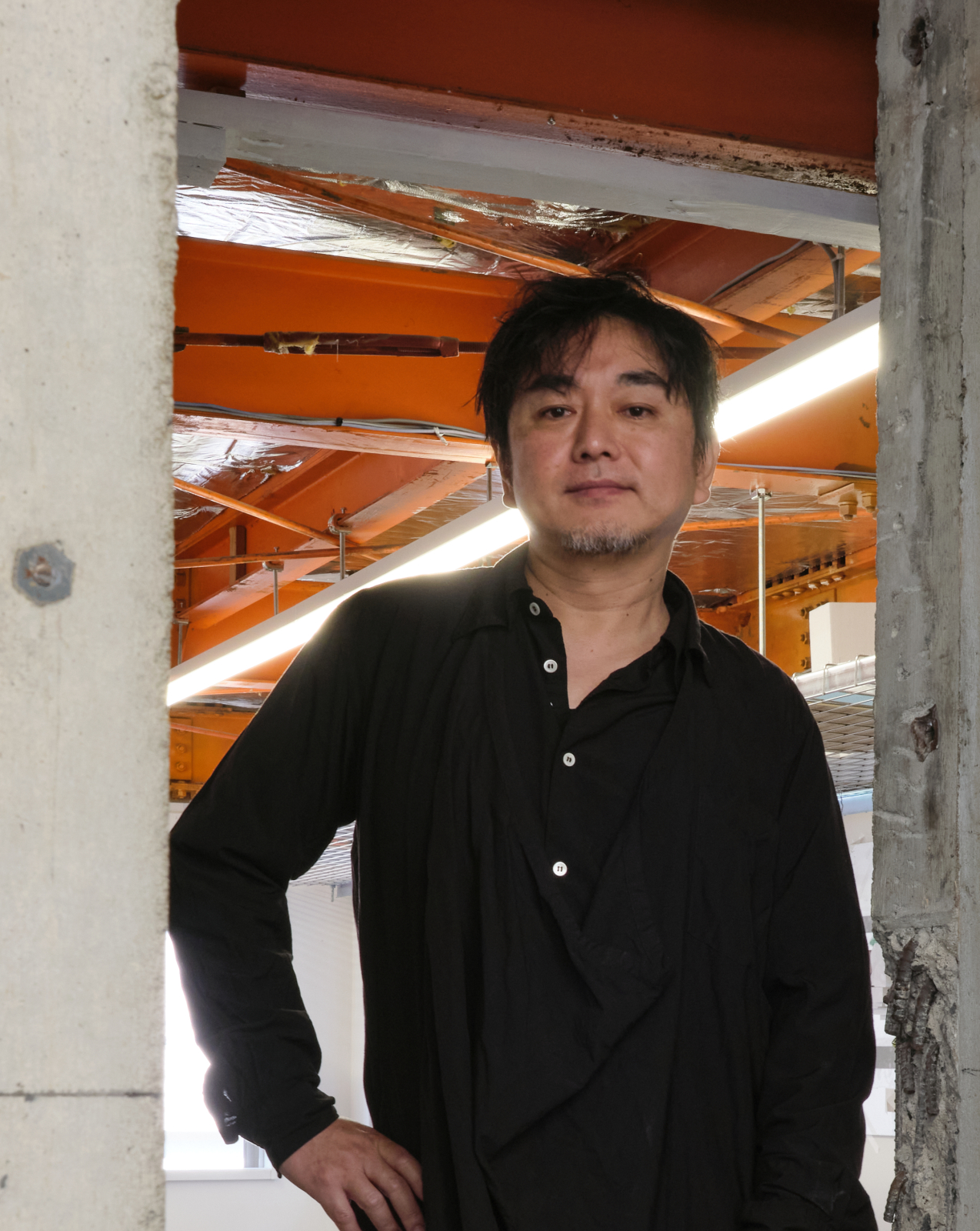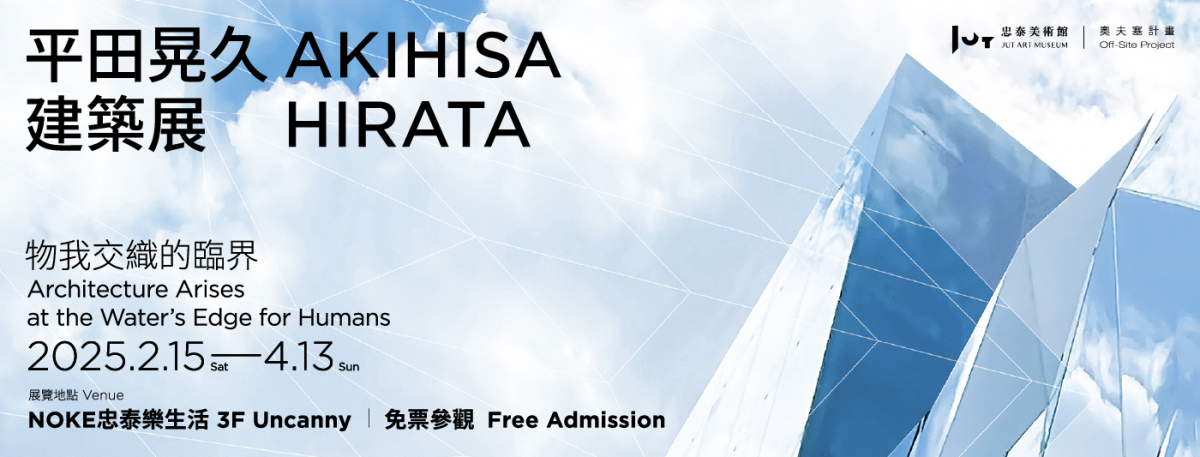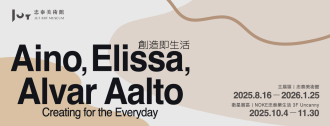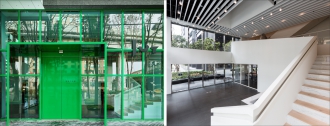Venue|NOKE 3F Uncanny (No. 200, Lequn 3rd Rd., Zhongshan Dist., Taipei City 104, Taiwan)
Preface
Text / Jut Art Museum
The Jut Art Museum’s “Off-Site Project 2025” features Akihisa Hirata: Architecture Arises at the Water’s Edge for Humans, marking the museum’s second invitation to Hirata to showcase his recent works after a six-year hiatus since his solo exhibition Human Nature: Generosity and Its Form staged in Taiwan in 2019. Akihisa Hirata, an architect from Japan, was born in 1971 and apprenticed to Toyo Ito. As a winner of many awards for up-and-coming, talented architects, Hirata is known for his combined strengths in discourse and design, which has made him an iconic Japanese architect of the middle generation. He has also designed quite a few architectural works in Taiwan, and each of these masterpieces bears his unique signature.
The content of this exhibition follows Hirata’s consistent architectural philosophy of karamari-shiro (entangling base), which interprets the forms of architectural spaces by observing the natural order, treating architecture as an ecosystem, a domain in which humans, organisms, and nature intertwine harmoniously. This exhibition further examines the invisible dimensions such as human consciousness, perception, and space-time, transforming them into architectural works and “reverberations” that have many resonances so as to explore new possibilities of future architecture.
As an art museum focusing on the issues about future and urban architecture, the Jut Art Museum launched its “Off-Site Project,” a long-term artistic practice that invites creators to present their works on atypical exhibition sites instead of in established venues of museums and meanwhile define the term “off” by dint of their architectural and artistic praxis. Providing a fascinating glimpse at Hirata’s architectural philosophy, this exhibition not only blends the role of humanity into the imagination of nature but also delves deeper into the inner essence of Hirata’s creative thinking, which will ultimately inspire visions, thoughts, and brainstorming of sheer vibrancy for the future of our cities and living environments on an organic, liberal territory.
Architecture Arises at the Water’s Edge for Humans
Text / Akihisa Hirata
We are living in an age in which human beings are connected once again to other living beings and are being transformed together. Architecture will also be transformed. However, I think a new architecture will take shape when it goes a bit beyond the expectations for human beings as assumed by modernity—this is what I would call the “water’s edge” for human beings. *
Until this point, I have tried to find a new architecture by approaching three types of water’s edge, and they are shown in the three themes of this exhibition.
I. Karamari-shiro: The Water’s Edge for the Body
II. Reverberations: The Water’s Edge for the Consciousness
III. Reverberations of Reverberations: The Water’s Edge of Space-Time
At the water’s edge for the body, human beings are rediscovered as having animal instincts. The concept of karamari-shiro (entangling base) is essential to thinking about architecture in this regard.
The water’s edge of the consciousness arises only when the collective consciousness goes beyond individual thinking. Someone else, who is not me, somewhere other than here, at a time that is not present drifts to the water’s edge of time-space. Here, reverberations become the source of inspiration for architecture.
Entangling and resonating—they are the two keys we obtained to shake up the human condition that has made modern architecture unshakable.
We will continue searching for possibilities for future architecture beyond the water’s edge for human beings. We will be imagining a future in which communications in the natural environment, AI and the human intellect coexist.
_______________________
* My concept of “the water’s edge” was inspired by the following two sentences I like:
“Man would be erased, like a face drawn in the sand at the edge of the sea.” —Michel Foucault, The Order of Things.
“I do not know what I may appear to the world, but to myself I seem to have been only like a boy playing on the seashore, and diverting myself in now and then finding a smoother pebble or a prettier shell than ordinary, whilst the great ocean of truth lay all undiscovered before me.” —Isaac Newton, as cited in David Brewster, Memoirs of the Life, Writings and Discoveries of Sir Isaac Newton.
- Exhibition|Akihisa Hirata - Architecture Arises at the Water’s Edge for Humans
- Date|2025.2.15(Sat.)-2025.4.13(Sun.)
- Venue|NOKE 3F Uncanny (No. 200, Lequn 3rd Rd., Zhongshan Dist., Taipei City 104, Taiwan)
- Opening Hours|SUN-THU 11:00-21:30, FRI-SAT 11:00-22:00
- Admission|Free Admission
- Organizer|Jut Art Museum
- Coordinators|Akihisa Hirata Architecture Office, Jut Art Museum
- Sponsors|JUT Group, Pauian Archiland
- Event Partners|NOKE JUT RETAIL, ZSC, SKIRESORT CURRY, ONIBUS, TSUTAYA BOOKSTORE-NOKE
- Venue Partner|Uncanny
- Cooperator|Nerima Art Museum (Nerima Cultural Promotion Association)
Architect
Akihisa Hirata

Born in 1971, Osaka Prefecture, Akihisa Hirata earned his bachelor degree of architecture and master degree of engineering from Kyoto University. After working for Toyo Ito & Associates, Architects, Akihisa Hirata established his own firm. In addition to leading his Akihisa Hirata Architecture Office, he is also an architecture professor of Kyoto University. Akihisa Hirata is the winner of many architecture awards, including the Asakura Award of SD REVIEW (2004), JIA New Face Award (2008), Golden Lion at the 13th International Architecture Exhibition – La Biennale di Venezia (2012), the ADAN Prize (2015), and the 31st Murano Togo Prize (2018). He has won several architecture design competitions in Taiwan in recent years, such as Hsinchu Municipal Library Design Competition (2019) and NTU Center for the Arts Design Competition (2022). Akihisa Hirata’s solo exhibition HUMAN NATURE: Generosity and Its Form (2019) in Jut Art Museum, Taipei won the Golden Pin Design Award in 2020.
Exhibition Team
- Exhibition Supervisors|Aaron Y. L. Lee, Alex Y. H. Lee, Shan-Shan Huang
- Exhibition Coordinators|Ying-Peng Chen, Chia-Ching Lin (Jut Art Museum)
Exhibition Coordinators| Yuko Tonogi, Akane Takahashi, Kanaho Tanimoto (Akihisa Hirata Architecture Office) - Assistant Coordinators| Yu-Chen Tsai, Yen-Hsiu Chen (Jut Art Museum)
Assistant Coordinators| Yeh Yun-Chih (Akihisa Hirata Architecture Office) - Communication and Marketing Coordinator|Chi-Yun Chang
- Communication and Marketing|Yen-Shan Li, Yu-Chin Liou, Yi-Ning Lin
- Public Service|Tsung-Ping Hung, Pei-Chun Tsai
- Administration Coordinator|Hsin-Yi Lin
- Special Design|Akihisa Hirata Architecture Office
- Graphic Designer|Min-Wei Liu
- Lighting Design|LigtTemp
- Multimedia Design|UN ART



